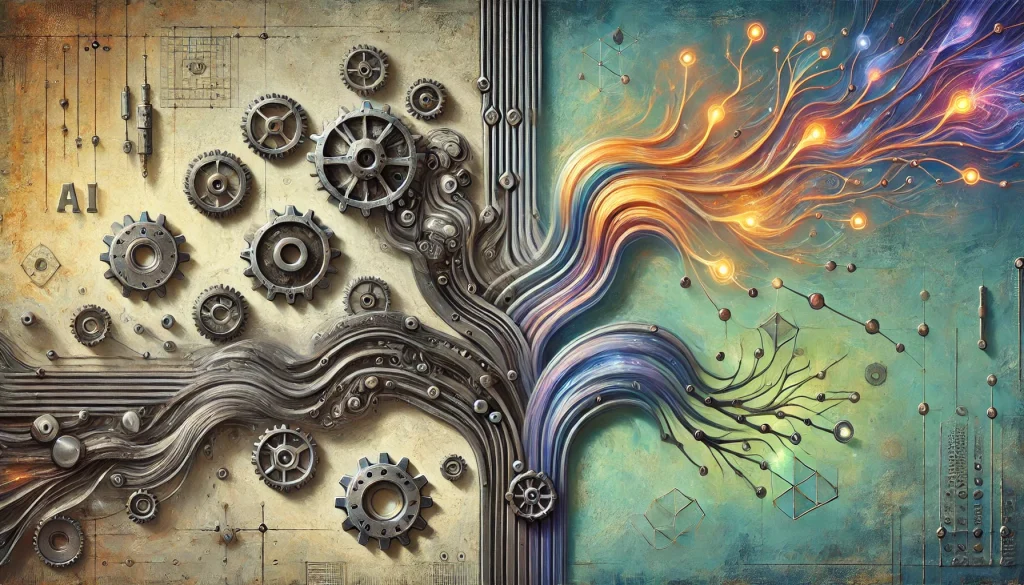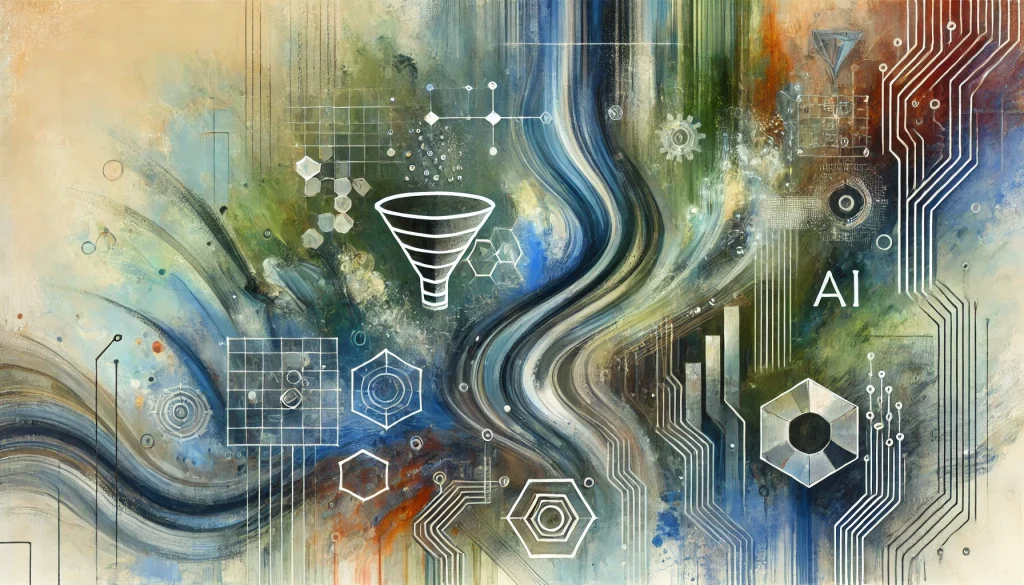- AI Funnels Adapt in Real-Time – Unlike traditional automation tools, AI funnels adjust their behavior instantly based on live data, customer signals, and performance feedback—no manual updates needed.
- Hyper-Personalization at Scale – AI funnels create dynamic, individualized customer journeys using hundreds of data points. Traditional automation relies on basic triggers and broad segments.
- Higher ROI, Fewer Bottlenecks – Though initial setup is steeper, AI funnels reduce manual work, boost conversions, and outperform rule-based systems over time—making them ideal for scaling.

AI funnels represent a new era in marketing automation.
AI Funnels Think While Traditional Tools Just Follow Rules
The marketing automation landscape has undergone a dramatic transformation in recent years. While traditional automation tools have served businesses well for decades, the emergence of AI-powered funnels represents a fundamental shift in how we approach customer journey optimization and conversion strategies. Understanding these differences is crucial for businesses looking to stay competitive in today’s data-driven marketplace. AI funnels vs traditional automation-let’s dive in.
The Foundation of Traditional Automation Tools
Traditional automation tools have been the backbone of digital marketing for years, operating on a relatively straightforward premise. These systems follow predetermined rules and workflows that marketers manually create and configure. When a specific trigger occurs, such as a user subscribing to an email list or abandoning a shopping cart, the system executes a pre-programmed sequence of actions.
The strength of traditional automation lies in its predictability and control. Marketers can map out every step of the customer journey, creating detailed flowcharts that account for various scenarios. These tools excel at handling routine tasks like sending welcome emails, scheduling social media posts, or moving leads through predefined stages of a sales funnel.
However, traditional automation tools operate within fixed parameters. They cannot adapt their behavior based on real-time data analysis or learn from customer interactions. Every decision point must be manually programmed, and any changes to the workflow require human intervention. This rigidity, while providing control, also creates limitations in responsiveness and personalization capabilities.
The Revolutionary Approach of AI Funnels vs Traditional Automation
AI funnels represent a paradigm shift from rule-based automation to intelligent, adaptive systems. These advanced platforms leverage machine learning algorithms, natural language processing, and predictive analytics to create dynamic, self-optimizing customer journeys. Unlike their traditional counterparts, AI funnels can analyze vast amounts of data in real-time and make autonomous decisions about the best course of action for each individual prospect.
The core difference lies in the system’s ability to think and learn. AI funnels continuously analyze customer behavior patterns, engagement metrics, and conversion data to identify opportunities for optimization. They can recognize subtle patterns that human marketers might miss and adjust their strategies accordingly. This creates a more responsive and effective marketing system that evolves with your audience.
AI funnels also excel at personalization at scale. While traditional tools might segment audiences into broad categories, AI systems can create micro-segments or even individual customer profiles, delivering highly targeted content and offers that resonate with each prospect’s specific needs and preferences.
Personalization Capabilities: Static vs Dynamic
The personalization gap between traditional automation and AI funnels is perhaps the most significant differentiator. Traditional tools typically rely on basic demographic information and simple behavioral triggers to customize content. A typical workflow might send different email sequences based on whether someone downloaded a specific lead magnet or visited certain pages on your website.
AI funnels take personalization to an entirely different level. These systems analyze hundreds of data points about each prospect, including browsing behavior, engagement patterns, social media activity, and even the time of day they’re most likely to interact with content. The AI can then dynamically adjust messaging, timing, and channel selection for each individual.
Consider a scenario where two prospects with similar demographics enter your funnel. Traditional automation might treat them identically, sending the same sequence of emails at predetermined intervals. An AI funnel, however, might detect that one prospect prefers video content and engages more on weekends, while the other responds better to text-based content during weekday mornings. The AI would automatically customize the content format and delivery timing for each individual without any manual intervention.
This level of dynamic personalization extends beyond content delivery to include offer optimization, pricing strategies, and even the communication channel selection. AI funnels can determine whether a prospect is more likely to convert through email, SMS, retargeting ads, or direct mail, then automatically route them through the most effective channel.
Learning and Adaptation: The Intelligence Factor
Traditional automation tools operate on a “set it and forget it” principle. Once configured, they continue executing the same workflows indefinitely unless manually updated. While this consistency can be valuable, it also means missing opportunities for improvement and adaptation as market conditions change.
AI funnels incorporate continuous learning mechanisms that constantly refine their performance. Machine learning algorithms analyze the outcomes of every interaction, identifying which approaches generate the best results for different types of prospects. This data feeds back into the system, automatically updating decision-making processes and optimization strategies.
The learning process extends beyond simple A/B testing. While traditional tools might compare two email subject lines to determine which performs better, AI systems can simultaneously test dozens of variables across multiple touchpoints. They can identify complex interaction effects between different elements of your funnel and optimize accordingly.
This adaptive capability means that AI funnels become more effective over time. As they process more data and interactions, their predictions become more accurate, their personalization more precise, and their conversion rates typically improve. Traditional automation tools, by contrast, perform at a consistent level unless manually optimized by human marketers.
Data Processing and Decision Making
The data processing capabilities of AI funnels far exceed those of traditional automation tools. Traditional systems typically work with structured data in predefined formats, making simple logical decisions based on clear rules. They might track basic metrics like email opens, clicks, and conversions, but their analysis remains relatively surface-level.
AI funnels can process both structured and unstructured data from multiple sources simultaneously. They can analyze text sentiment in customer communications, recognize patterns in social media behavior, correlate weather data with purchase decisions, and even incorporate external market trends into their decision-making processes.
The decision-making process itself is fundamentally different. Traditional automation follows “if-then” logic trees that marketers have manually constructed. AI systems use probabilistic models that weigh multiple factors simultaneously to determine the optimal action. They can consider the likelihood of various outcomes and choose strategies that maximize expected value rather than simply following predetermined rules.
This sophisticated decision-making capability enables AI funnels to handle complex scenarios that would overwhelm traditional automation systems. They can balance multiple objectives simultaneously, such as maximizing conversion rates while maintaining customer satisfaction and lifetime value.
Real-Time Optimization and Response
Traditional automation tools typically operate on scheduled intervals, executing batch processes at predetermined times. While they can respond to immediate triggers like form submissions or purchase events, their optimization cycles are usually measured in days or weeks. Marketers must manually analyze performance data, identify improvement opportunities, and implement changes.
AI funnels optimize in real-time, adjusting their behavior based on immediate feedback and changing conditions. If an AI system detects that conversion rates are dropping for a particular segment, it can immediately test alternative approaches and implement improvements without waiting for human intervention.
This real-time responsiveness extends to external factors as well. AI funnels can adjust their strategies based on seasonal trends, current events, competitor actions, or changes in market conditions. They might automatically modify messaging during an economic downturn or adjust promotional strategies during peak shopping seasons.
The speed of optimization creates a significant competitive advantage. While businesses using traditional automation might take weeks to identify and address performance issues, AI-powered systems can detect and correct problems within hours or even minutes.
Integration and Ecosystem Connectivity
Traditional automation tools often operate in silos, with limited integration capabilities beyond basic API connections. They typically focus on specific channels like email marketing or social media management, requiring businesses to piece together multiple tools to create comprehensive customer journeys.
AI funnels are designed with integration as a core principle. They can seamlessly connect with CRM systems, e-commerce platforms, social media channels, advertising networks, and customer service tools to create unified customer experiences. More importantly, they can analyze data from all these sources simultaneously to make more informed decisions.
The integration extends beyond data sharing to include coordinated action across channels. An AI funnel might detect that a prospect is highly engaged with your brand on social media and automatically trigger a personalized email sequence while simultaneously adjusting their retargeting ad frequency and content.
Cost Considerations and ROI Implications
The cost structure of AI funnels differs significantly from traditional automation tools. Traditional tools typically have lower upfront costs and predictable monthly fees based on list size or feature access. The primary investment is in setup time and ongoing management.
AI funnels often require higher initial investments, both in technology costs and implementation resources. However, their ability to automatically optimize performance and reduce manual management can lead to significant long-term cost savings. The improved conversion rates and reduced need for constant human intervention often result in superior ROI over time.
The cost equation also includes opportunity costs. Traditional automation tools require ongoing human expertise to maintain and optimize performance. AI funnels reduce this dependency, freeing marketing teams to focus on strategy and creative development rather than technical management.
Implementation Complexity and Learning Curves
Traditional automation tools are generally easier to understand and implement. Their rule-based logic aligns with how most marketers naturally think about customer journeys. The learning curve is relatively gentle, and most marketing teams can become proficient quickly.
AI funnels present a steeper learning curve, requiring marketers to understand new concepts like machine learning, predictive analytics, and algorithmic optimization. However, many modern AI platforms are designed with user-friendly interfaces that abstract away technical complexity while still providing powerful capabilities.
The implementation process for AI funnels often involves more initial setup and data integration work, but this investment pays dividends through reduced ongoing management requirements and superior performance.
Future-Proofing Your Marketing Strategy
The marketing landscape continues to evolve rapidly, with increasing customer expectations for personalized experiences and real-time responsiveness. Traditional automation tools, while reliable, may struggle to meet these evolving demands without significant manual enhancement.
AI funnels are inherently designed to adapt to changing conditions and requirements. Their learning capabilities mean they can evolve alongside your business and market conditions. As new data sources become available or customer preferences shift, AI systems can incorporate these changes into their optimization processes automatically.
The competitive advantage of AI funnels becomes more pronounced over time. As these systems accumulate more data and refine their algorithms, the gap between AI-powered and traditional automation becomes increasingly significant.
Making the Right Choice for Your Business
The decision between traditional automation tools and AI funnels depends on various factors including business size, technical resources, budget, and growth objectives. Traditional tools remain valuable for businesses with straightforward automation needs, limited budgets, or those just beginning their marketing automation journey.
AI funnels are increasingly becoming the preferred choice for businesses serious about scaling their marketing efforts, improving conversion rates, and staying competitive in data-driven markets. The technology has matured to the point where implementation barriers are lower while the potential benefits continue to grow.
Understanding these fundamental differences empowers businesses to make informed decisions about their marketing technology stack. Whether you choose traditional automation or AI-powered funnels, the key is selecting tools that align with your business objectives and growth strategy while providing room for future expansion and optimization.
The evolution from traditional automation to AI funnels represents more than just a technological upgrade. It signifies a fundamental shift toward more intelligent, responsive, and effective marketing systems that can adapt to the complex realities of modern customer journeys. As this technology continues to advance, the businesses that embrace these capabilities will be best positioned to thrive in an increasingly competitive marketplace.
Stop Losing Leads. Start Closing Deals
Let BotHaus.ai build your done-for-you AI funnel — so you never miss a lead, forget a follow-up, or waste hours chasing cold prospects again.
👉 Start for free — we’ll build it first, you pay only if you love it.
Frequently Asked Questions
Question: What is the main difference between AI funnels and traditional automation tools?
Answer: Traditional tools follow fixed, rule-based workflows. AI funnels adapt in real time using machine learning and customer behavior data.
Question: Are AI funnels harder to implement than traditional tools?
Answer: They require more setup initially, but modern platforms simplify the process. Once live, AI funnels need less ongoing manual input.
Question: Do AI funnels really improve conversion rates?
Answer: Yes. AI funnels personalize content, timing, and channels for each user—leading to better engagement and higher conversions.
Question: Can AI funnels integrate with my existing systems?
Answer: Most AI platforms integrate with CRMs, ad tools, and ecommerce platforms for seamless data flow and coordination.
Question: Are AI funnels more expensive?
Answer: Upfront costs can be higher, but they typically save money over time by improving results and reducing manual workload.
Question: Do I need technical skills to use an AI funnel?
Answer: No. Most AI funnel platforms are designed with user-friendly interfaces for marketers and small business owners.
Question: Why should I switch to an AI funnel now?
Answer: Customer expectations are rising. AI funnels offer smarter automation, faster response times, and stronger ROI.

